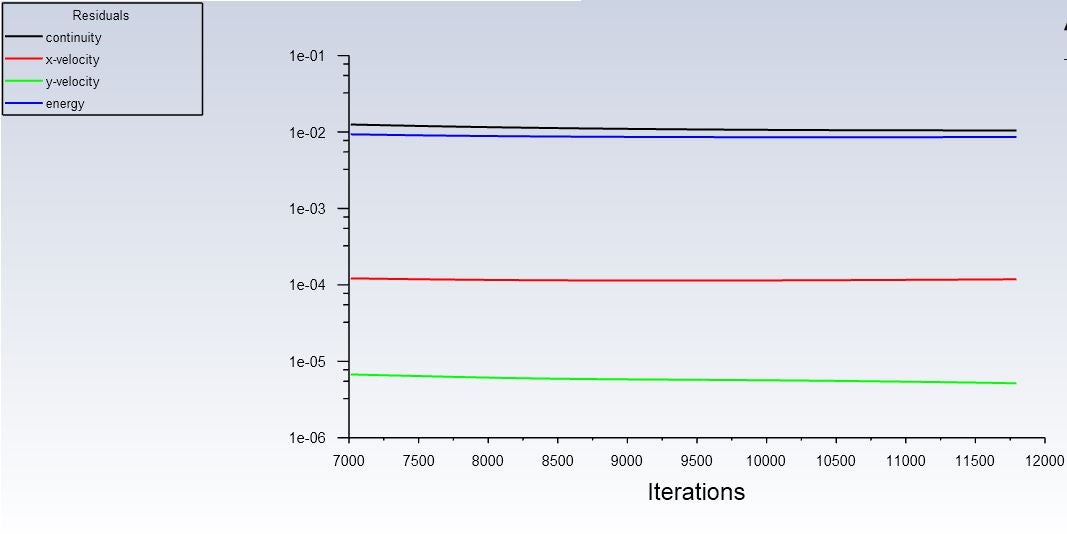TAGGED: 2D, ansys-fluent, cfd, convergence, fluent
-
-
August 29, 2021 at 10:11 am
Jet
SubscriberHello everyone
I'm trying to solve an underexpanded Nanojetgrid - so a 2D axisymm. domain, symmetry cond. on one long side, symm.axis on another, jet diameter of 1000nm - density based because M>1 expected, helium as fluid (sutherland for viscosity) and laminar model because low Re expected. Pressure inlet and outlet as boundary conditions and overall steady behavior.
I thought i had the problem reasonably good defined. Now I can't get it to converge properly, or at least it takes unreasonably long to get any kind of halfsensical solution. With a good initialization i got the x-vel and y-vel more or less down but continuity and energy never really drop lower than 10-e3.
August 30, 2021 at 1:35 pmRahul Kumar
Ansys EmployeeHello,
Can you also please give us information about the solution methods you using and the version? Please check the fluxes and monitor a variable of interest at a particular location to get a better idea of the behavior of the simulation.
August 30, 2021 at 4:18 pmJet
SubscriberI'm working out of the Fluent module in Ansys Workbench 2021 R2 (Studentversion) - also double precision and 4-process.
Solution Methods: Implicit Formulation (also tried with explicit), Roe-FDS, Least Squares Gradient, Third Order MUSCL Flow (tried with the other two too, this one i felt like gave a slightly faster convergence at first), none of the check-box options below that
Controls: Courant Number: 5. (max i could do was up to 7, then it straight up diverged) and Under-relaxation-factor I didn't touch.
Thank you, I will check how net mass flow rate and maybe Mach Number or velocity mag. at the jet throat behave during the simulation and report back
August 30, 2021 at 4:37 pmRahul Kumar
Ansys EmployeeYou can also try with Green Gauss Node based and keeping the flow to second order. check Higher Order Term Relaxation too.
August 30, 2021 at 8:14 pmJet
SubscriberDid as you said, i think it converged slightly faster, the behavior tough is the same. After now 12000 it's basically leveled out. Mach-Nr in the middle of the jet/pore exit as well as net mass flow rate also leveled out proportional to the residuals - they just dropped on a nice curve. Mach-Nr. is about 0.04 which is (even tough measurepoint is kinda little "much to the left") much lower than expected. Net mass flow between inlet and outlet is surprisingly negative - its really small tough (e-11) but the domain is also really small.
Contour of velocity magnitude looks similar to the one posted above. I'm having a really hard time interpreting this behavior. Is there anything else I could try or another angle I could work on? Thank you very much for all the tips so far!
August 31, 2021 at 3:29 pmRahul Kumar
Ansys EmployeeI am sorry, I did not understand what you mean by "levelled out", "dropped on a nice curve", "kinda little "much to the left"". Images and plots will help to understand better.
Regarding the mass flux, you will have find out the error percentage. Can you please let me the % error?
Another way to improve convergence is by FMG initialization.
August 31, 2021 at 7:39 pmJet
SubscriberSorry, i should've been more technical. After 12000 iterations there is nearly no change in the residuals anymore.
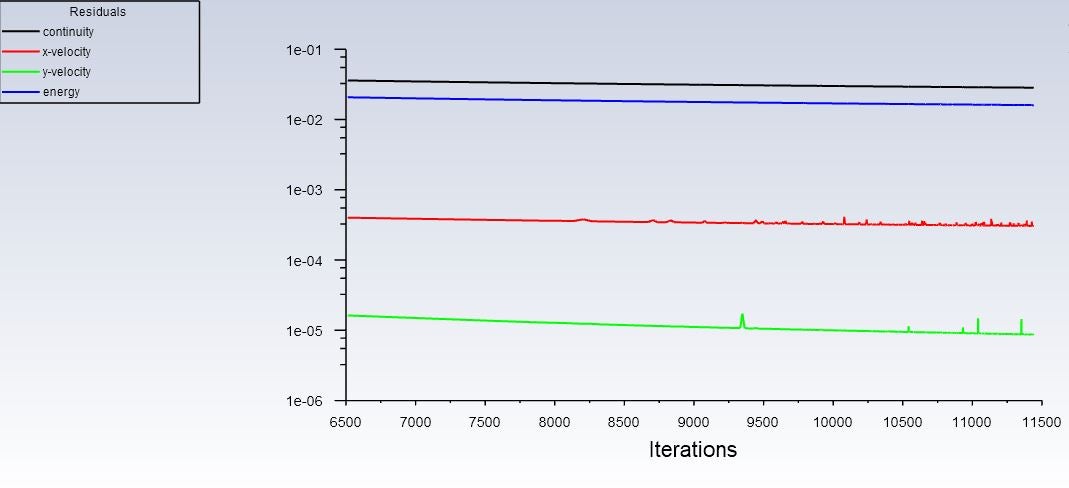 The velocity magnitude contour looks like this. I should mention that the pressure difference between inlet and outlet is per boundary condition 5bar.
The velocity magnitude contour looks like this. I should mention that the pressure difference between inlet and outlet is per boundary condition 5bar.
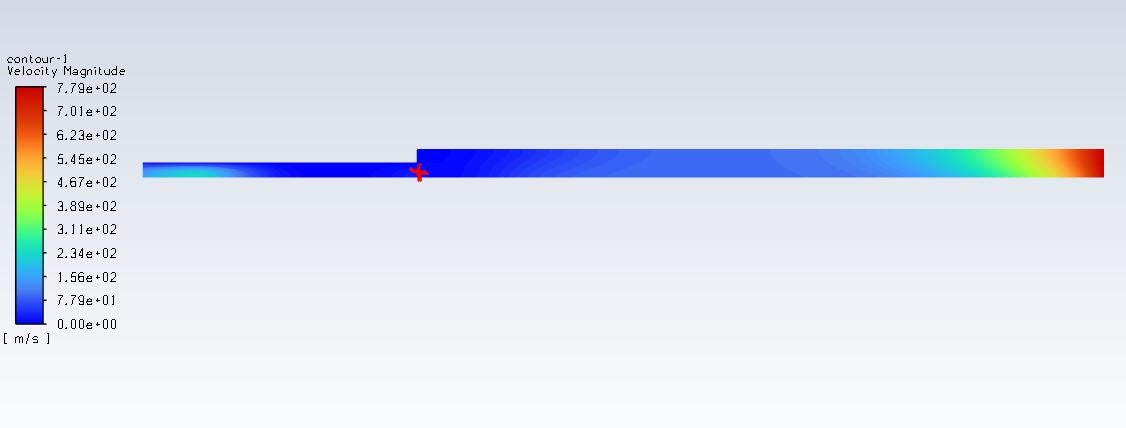 The red mark is exactly in the middle of the exit of the pore/jet and marks the point at which the Mach-Nr. for the following graph was taken. I expect there to be at least a few Mach-diamonds - so the max Mach-Nr. is probably not at the point of the mark (the point is a little to the left to where the max Mach-Nr. is supposed to be); still, the Mach-Nr. is much too low.
The red mark is exactly in the middle of the exit of the pore/jet and marks the point at which the Mach-Nr. for the following graph was taken. I expect there to be at least a few Mach-diamonds - so the max Mach-Nr. is probably not at the point of the mark (the point is a little to the left to where the max Mach-Nr. is supposed to be); still, the Mach-Nr. is much too low.
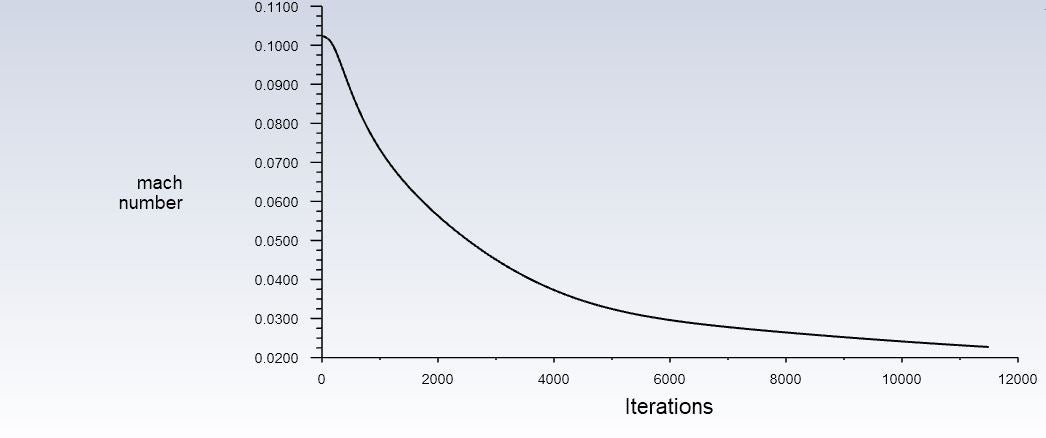 The following is the net flow of inlet and outlet over the iterations, it's approx. -1.5e-10. (fluent says inlet is 4.22e-11 outlet is -1.9e-10 ).
The following is the net flow of inlet and outlet over the iterations, it's approx. -1.5e-10. (fluent says inlet is 4.22e-11 outlet is -1.9e-10 ).
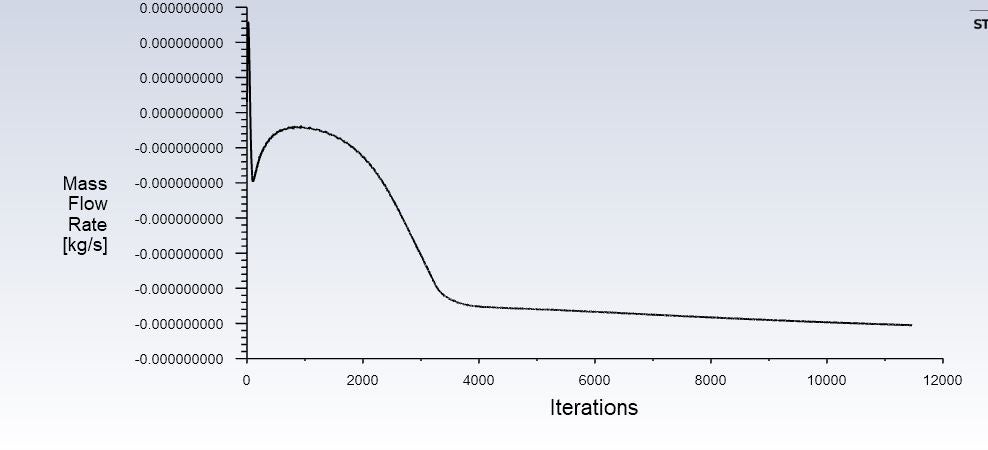 As i mentioned, i had this behavior of the residuals before and let it run up to 130.000 iterations. Is it possible that this kind of simulation really just needs much more iterations to give a good solution?
As i mentioned, i had this behavior of the residuals before and let it run up to 130.000 iterations. Is it possible that this kind of simulation really just needs much more iterations to give a good solution?
Another question that came up: does fluent have any kind of size limitations in regards to the domain in which it can resolve problems? I didn't think so but i did a run (per accident) in which i scaled up the domain 18 times in both x and y with everything else staying the same and I got a solution of an under-expanded jet that made sense. (I'm aware that this makes it a completely different kind of numerical problem but still, i thought i should mention it)
I asked before but didn't get an answer: Is it a problem to have both an pressure inlet AND an pressure outlet?
I will look into FMG initialization and try to incorporate that. Thank you for you answer.
Viewing 6 reply threads- The topic ‘Underexpanded Nanojet – Slow convergence’ is closed to new replies.
Innovation SpaceTrending discussions- air flow in and out of computer case
- Varying Bond model parameters to mimic soil particle cohesion/stiction
- Eroded Mass due to Erosion of Soil Particles by Fluids
- I am doing a corona simulation. But particles are not spreading.
- Centrifugal Fan Analysis for Determination of Characteristic Curve
- Guidance needed for Conjugate Heat Transfer Analysis for a 3s3p Li-ion Battery
- Issue to compile a UDF in ANSYS Fluent
- JACOBI Convergence Issue in ANSYS AQWA
- affinity not set
- Resuming SAG Mill Simulation with New Particle Batch in Rocky
Top Contributors-
4062
-
1487
-
1308
-
1156
-
1021
Top Rated Tags© 2025 Copyright ANSYS, Inc. All rights reserved.
Ansys does not support the usage of unauthorized Ansys software. Please visit www.ansys.com to obtain an official distribution.
-

